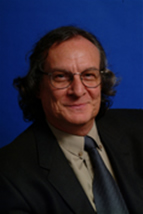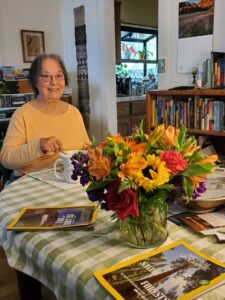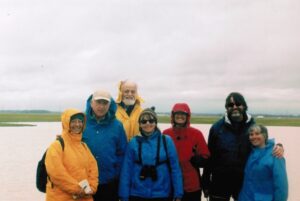by Barbara Vlamis
Kyran “Kim” Daniel Mish was born in 1952 and escaped the confines of human life in 2023.
His professional experience was mostly concentrated in the development and deployment of large-scale computational models for engineered and natural systems (see more below). My first really clear memory of Kim was at the Barris’ Durham home in the 1990s, where he almost danced around the living room as he explained how aquifers work. Part of the drama was a glass with stones in it to illustrate pores. The energy and enthusiasm were a little overwhelming at first, but contagious. Not long after that, Kim described the form of science used by California water agencies as “put your finger in an electrical outlet to see what happens!” (See footnote for later elaboration. [1])
Kim’s humor was endlessly available and entertaining in the depths of very serious discussions together about challenging local, state, and federal agencies. “Their approach is to make a laundry list of assertions … that sound technical, but that really have no substance. It’s the environmental version of what… [Stephen] Colbert refers to as ‘truthiness,’ i.e., something that is intended to sound correct, but not to be correct.”
In December 1995, Kim presented material to help the public and policy makers grasp the issues with the Butte Basin Water Users Association groundwater model (lucky to have it on video). The audience was filled with skeptics, farmers, and county government folks who thought their first steps to understand the groundwater basin were unassailable. He dazzled them into silence.
In 2008 he returned and spoke about the importance of working together on science that would shape the future. Before he moved into natural and engineered systems, Kim provided one of his favorite quotes from author William Gibson: “The future is already here. It’s just unevenly distributed.” In other words, “if you know where to look, you can see the future,” he added. He complimented the foresight of the Bidwells who made decisions about land use planning, parks, and education from which the current population benefits and lauded local organizations that “want to make things better for everybody.”
Years later, although he lived many states away, Kim was still interested in our efforts in northern California. “There are several pithy retorts here, including the all-too-obvious realization that these statements ignore the fact that subsidence is by definition nonlinear (hence the ‘small disturbances can’t produce the problem’ — according to that view, then climate change cannot occur, either, nor can ANY irreversible phenomenon!), and the equally obvious problem that the absence of short-term evidence of subsidence doesn’t imply that it’s not happening, because the cause and the effect of subsidence in clays can be widely separated in time… just ask the folks in the San Joaquin Valley!” (2013)
Kim confided that his attachment to northern California started in his young adult years when he lived in the Salmon Mountains west of Mount Shasta. At that time, his background was in biology, so he loved hiking in the conifers and worked on the effort to stop a paved road for logging that would have devastated lands used for sacred purposes by the Karuk, Tolowa, and Yurok Indian tribes. [2]
In 2014, Kim put his talents to work to benefit the public and California during the State’s effort to construct the Twin Tunnels that planned to syphon massive amounts of water from the Sacramento River for points south of the Delta. He also evaluated the One Tunnel proposal in 2022. Of course we communicated many times during the near collapse of Oroville Dam in February 2017. “I’ve been really worried about the safety of the reservoir since the main spillway blew out last week. We’ve seen this movie before: it’s eerily similar to the decisions (and engineering gaffes) that almost took out Glen Canyon Dam about 30 years ago.”
One of his college-aged sons asked him some time ago why he worked with me so long. He replied, “I worked with you because you and I were both on the same side in these various debates. He asked me what side we were on, and my answer was ‘the side of reality.’ I told him that you wanted accurate science and engineering in these water projects, and so did I, so we found ourselves working together.” (2008)
There was a period where our friendship became more personal as we explored the pain and distress of losing loved people. It finally felt like I could contribute to this dear man during a time when great intellect was not sufficient. In closing, here is what I placed on the obituary web site: “Dear Kim, Your absence from Earth brings waves of wishes: to hear your voice, to engage with your tremendous energy and mind, to plan how to stop the next insidious water plan, to hear about your love of places and people. You are greatly missed!”
Professional Background (written by Kim Mish in 2022 with critique of the One Tunnel project):
Kyran Daniel Mish has long provided pro bono independent technical assessments about topics of relevance to California resource allocation practices. His service in these roles has been motivated by the desire to include the public interest in resource allocation decisions, and his work has involved collaborations with various environmental organizations in California.
Mish has served on the Engineering and Applied Mathematics faculty of the University of California, Davis, and in the faculty ranks of the School of Civil Engineering and Environmental Science at the University of Oklahoma. He served as the founding director of the Center for Computational Engineering at Lawrence Livermore National Laboratories, and although he no longer lives in California, he continues to find opportunities to contribute to public discussions on topics in engineering and science in the Golden State. Mish’s educational background is from the University of California, Davis, where he earned a B.S. in applied mathematics, and M.S. and Ph.D. degrees in Civil Engineering.
[1] Mish, Kyran D. 2008. Commentary on Ken Loy GCID Memorandum. p. 7.
“Towards a Better Plan for Characterizing Aquifer Response
“The GCID [Glenn Colusa Irrigation District] plan is not scientific research in any recognizable form. It is more akin to Russian Roulette, in that “the experiment” amounts to acting out a proposed plan of action without due regard for the risks inherent in that plan. If we want to know what happens when we stick our finger in an electric outlet, we can either (a) just stick our finger in the outlet and thus “do the experiment” or we could instead (b) learn more about the physics of fingers and outlets and thus construct a good model for the action, but with a more realistic assessment of the risks involved. Note that only the latter approach ‘does no harm.’
“Learning how an aquifer responds to large-scale groundwater extraction by simply pumping water out of it without due attention to the risks and uncertainties involved does not constitute science, any more than jamming a finger into a wall outlet is science. The aquifer deserves better science that this, and so do the people of Northern California.”
[2] For a comprehensive history of this proposed road project, see material by Professor Emeritus JeDon Emenhiser, Department of Politics, Cal Poly Humboldt: https://politics.humboldt.edu/g-o-road-controversy-american-indian-religion-and-public-land.






